Volunteer Time:
2006 (total): 103 days, 169 hours
2007 (total): 238 days, 425.75 hours
2008 (total): 86 days, 124.00 hours
May
6th, 2008:
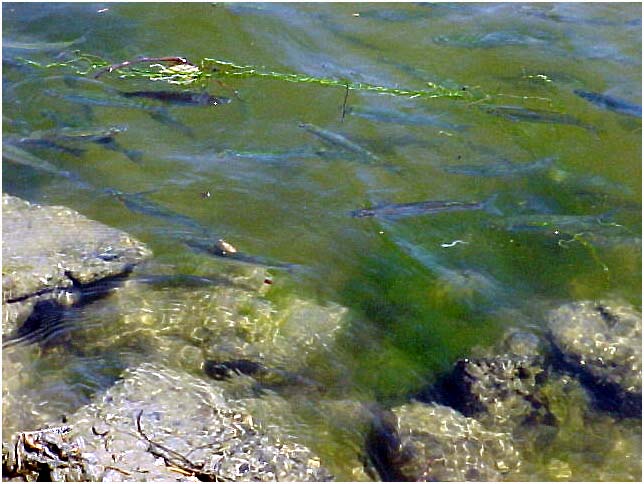 My attention was drawn to a loud commotion outside my RV today coming
from the Slough. The first thing I noticed were seagulls actually diving,
like pelicans, for fish that were swimming rather sluggishly on the surface
of the water.
My attention was drawn to a loud commotion outside my RV today coming
from the Slough. The first thing I noticed were seagulls actually diving,
like pelicans, for fish that were swimming rather sluggishly on the surface
of the water.
The fish were smelt which were congregating near the edge of
the water and were barely moving. My guess is that a combination of factors
had limited the oxygen in the Slough.
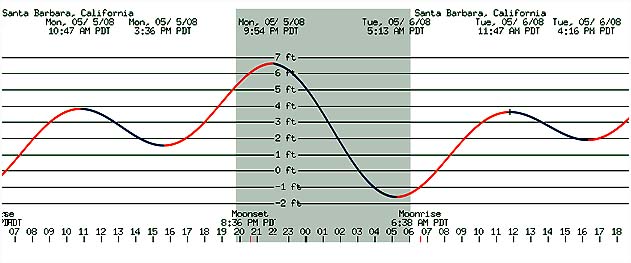
Last night's 9:54pm high tide was over six and a half feet which
tends to drive baitfish like smelt further up the Slough than usual.
The morning's outgoing tide dropped to a minus 1.61 feet by 5:13am
causing some baitfish to become stranded in the shallower portions of the
upper Slough. By the time the tide began returning and reached those stranded
fish they had almost exhausted the oxygen in the remaining water.
The new water level allowed them, even in their weakened condition,
to begin to float back down towards the mouth of the Slough. But,
as you can see in the picture, this new water (around 11am) was highly
discolored which is indicative of an algal bloom which deprived the escaping
smelt of the oxygen they needed to revive and successfully avoid the seagulls
waiting for them.
Interestingly only the seagulls and one lone vulture were feasting
on the smelt - the diving ducks, cormorants and pelicans were all rafting
offshore where the water was similarly discolored. They did not appear
to be feeding at all.
May
9th, 2008:
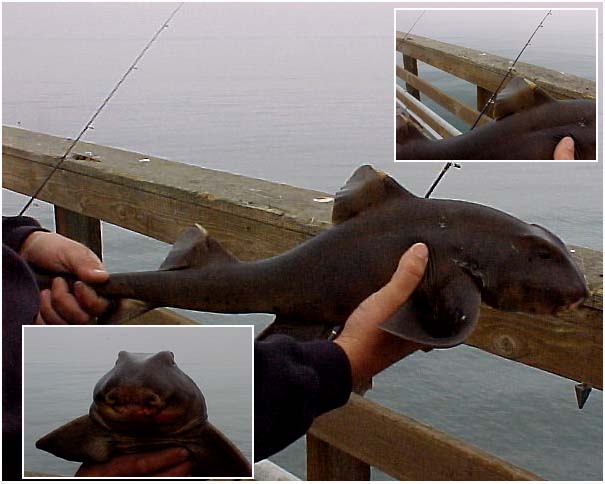 Although I haven't been posting pictures of fish caught off of the
Pier I wanted to share this one because it is a fairly
rare catch at Goleta. What you are looking at is a California Horn
Shark (Heterodontus francisci). It was brought
up from the kelp reef on the west side of the pier after taking a small
piece of cut squid used as bait.
Although I haven't been posting pictures of fish caught off of the
Pier I wanted to share this one because it is a fairly
rare catch at Goleta. What you are looking at is a California Horn
Shark (Heterodontus francisci). It was brought
up from the kelp reef on the west side of the pier after taking a small
piece of cut squid used as bait.
Since the fish has little food value it was subsequently released.
According to the Monterey
Bay Aquarium, "These small, elusive sharks prefer shallow
waters less than 40 feet deep. They spend their days hiding under ledges,
in caves or among kelp and other seaweeds; they hunt at night. Horn sharks
feed on seafloor invertebrates, especially sea urchins and crabs, and occasionally
on small fishes."
This shark, along with the Spiny Dogfish shark (Squalus
acanthias), is noted for the sharp and venomous spines in front
of each dorsal fin. These spines are used defensively to discourage other
fish from eating them. They are also used to help the shark wedge itself
into its daytime hiding places.
Unlike the Spiny Dogfish and most other sharks this one has a
short, blunt head with high ridges above the eyes typical of the bullhead
sharks which also have a pig-like snout and a small puckered mouth.
May
13th, 2008:
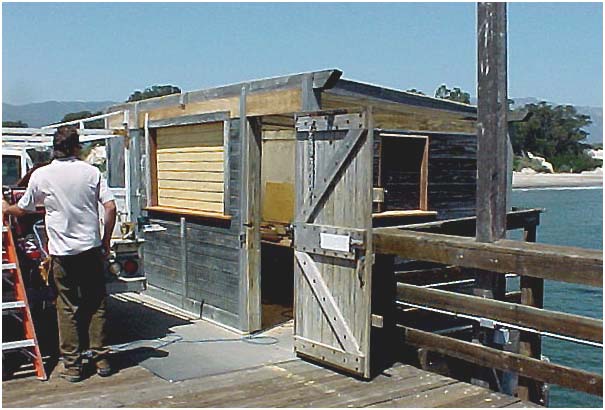 Steve, a County carpenter, has been working on the Marine Center
conversion since
Steve, a County carpenter, has been working on the Marine Center
conversion since
mid-April as time permits. There is no estimate as to when it
will be ready but I am still hoping some time this summer.
Since this project is being sponsored by a non-profit
educational organization the Center will be run like a Thrift Shop
but instead of clothing it will feature donated and reconditioned fishing
tackle.
This will give us an opportunity to make contact with the anglers
on the Pier and help familiarize them with the ethical angling concept
and environmentally sensitive fishing tackle and techniques.
May
14th, 2008:

This
3-24-08 video takes pier jumping to new heights ...
or
depths depending on your point of view
Seriously though I hope the County is paying attention to the
increasing number of videos on the web about jumping from Goleta Pier.
Some day someone is going to get seriously hurt and there could be questions
regarding the County's enforcement of its ordinance:
Sec. 26-82. Pier--No diving, swimming, etc., near pier.
No person shall dive from the Goleta
Beach Pier or swim, surf or jet ski within one hundred feet of the Goleta
Beach Pier. (Ord. No. 3708, § 1)
May
26th, 2008:
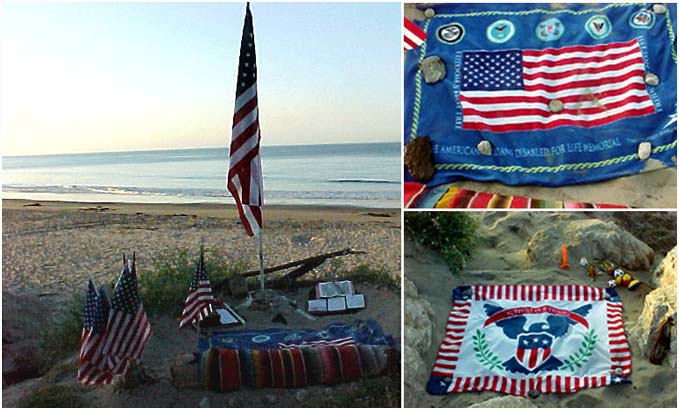 Found this display on the beach at dawn this morning ... similar
to last year's Memorial
Day tribute.
Found this display on the beach at dawn this morning ... similar
to last year's Memorial
Day tribute.
May
27th, 2008:
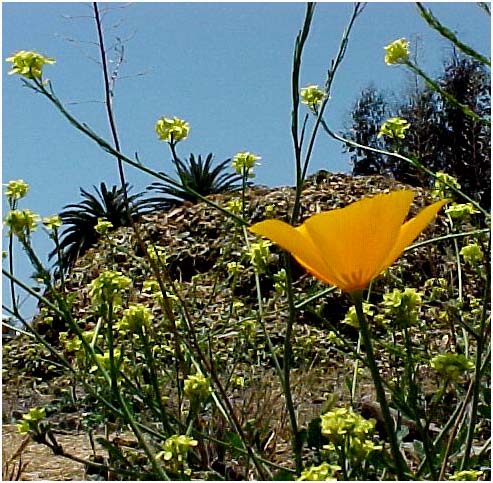
Unexpected acts of kindness ... watching the birdlife from the
East lot today I heard a bit of a commotion behind me.
Turning around I noticed a dump truck preparing to unload its
contents onto the County's compost pile. Directly in its way was this stalwart
poppy bravely facing its fate.
All of this had also been observed by one of the day campers
parked nearby.
Ecological disaster was narrowly averted when he warned the driver
in no uncertain terms that he was about to " ... bury a PROTECTED
CALIFORNIA WILDFLOWER!!!"
May
28th, 2008:
 Yesterday
while a poppy was being saved in the east parking lot the infamous cormorant
tree across from the restaurant was chopped down and rendered into wood
chips. Yesterday
while a poppy was being saved in the east parking lot the infamous cormorant
tree across from the restaurant was chopped down and rendered into wood
chips.
Actually it was several trees that had become entwined over the
years and grown together to become one of the tallest groupings in the
park. Unfortunately their proximity to the Slough attracted a colony of
cormorants who roosted in its topmost branches.
Cormorants are noted for prodigious amounts of 'whitewash' and
since they were roosting over multiple parking spaces they definitely had
an impact on the restaurant's visitors. For awhile they were deterred
by automated predator calls but they always reestablished themselves. Then
in September 2007 the tree shed
a major limb with near disastrous results.
While there was no question as to the necessity of this sacrifice
on the altar of public safety I was surprised at
the depth of local reaction.
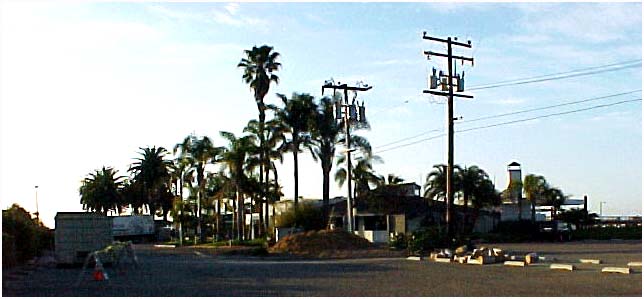
May
29th, 2008:
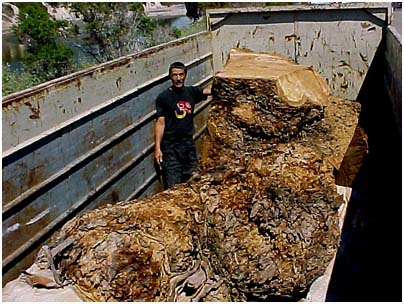
This is the stump of the largest of the three eucalyptus trees
that were removed on Tuesday.
I believe the trees were lemon-scented Eucalyptus (E. citriodora).
Ranger Dave says the largest was planted 30 years ago when he first started
working at the Park ... the Park was established after WWII.
Pictured is a section of burl wood that is seven and half by
five and a half feet in diameter.
The tree removal service used a large crane to deposit the stump
into the dumpster for later disposal. |